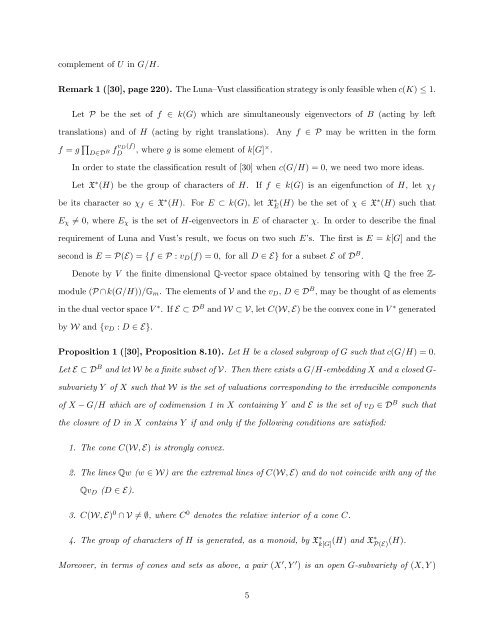Equivariant Embeddings of Algebraic Groups
Equivariant Embeddings of Algebraic Groups
Equivariant Embeddings of Algebraic Groups
You also want an ePaper? Increase the reach of your titles
YUMPU automatically turns print PDFs into web optimized ePapers that Google loves.
complement <strong>of</strong> U in G/H.<br />
Remark 1 ([30], page 220). The Luna–Vust classification strategy is only feasible when c(K) ≤ 1.<br />
Let P be the set <strong>of</strong> f ∈ k(G) which are simultaneously eigenvectors <strong>of</strong> B (acting by left<br />
translations) and <strong>of</strong> H (acting by right translations).<br />
f = g ∏ D∈D B f v D(f)<br />
D<br />
, where g is some element <strong>of</strong> k[G] × .<br />
Any f ∈ P may be written in the form<br />
In order to state the classification result <strong>of</strong> [30] when c(G/H) = 0, we need two more ideas.<br />
Let X ∗ (H) be the group <strong>of</strong> characters <strong>of</strong> H.<br />
If f ∈ k(G) is an eigenfunction <strong>of</strong> H, let χ f<br />
be its character so χ f ∈ X ∗ (H). For E ⊂ k(G), let X ∗ E (H) be the set <strong>of</strong> χ ∈ X∗ (H) such that<br />
E χ ≠ 0, where E χ is the set <strong>of</strong> H-eigenvectors in E <strong>of</strong> character χ. In order to describe the final<br />
requirement <strong>of</strong> Luna and Vust’s result, we focus on two such E’s. The first is E = k[G] and the<br />
second is E = P(E) = {f ∈ P : v D (f) = 0, for all D ∈ E} for a subset E <strong>of</strong> D B .<br />
Denote by V the finite dimensional Q-vector space obtained by tensoring with Q the free Z-<br />
module (P ∩k(G/H))/G m . The elements <strong>of</strong> V and the v D , D ∈ D B , may be thought <strong>of</strong> as elements<br />
in the dual vector space V ∗ . If E ⊂ D B and W ⊂ V, let C(W, E) be the convex cone in V ∗ generated<br />
by W and {v D : D ∈ E}.<br />
Proposition 1 ([30], Proposition 8.10). Let H be a closed subgroup <strong>of</strong> G such that c(G/H) = 0.<br />
Let E ⊂ D B and let W be a finite subset <strong>of</strong> V. Then there exists a G/H-embedding X and a closed G-<br />
subvariety Y <strong>of</strong> X such that W is the set <strong>of</strong> valuations corresponding to the irreducible components<br />
<strong>of</strong> X − G/H which are <strong>of</strong> codimension 1 in X containing Y and E is the set <strong>of</strong> v D ∈ D B such that<br />
the closure <strong>of</strong> D in X contains Y if and only if the following conditions are satisfied:<br />
1. The cone C(W, E) is strongly convex.<br />
2. The lines Qw (w ∈ W) are the extremal lines <strong>of</strong> C(W, E) and do not coincide with any <strong>of</strong> the<br />
Qv D (D ∈ E).<br />
3. C(W, E) 0 ∩ V ≠ ∅, where C 0 denotes the relative interior <strong>of</strong> a cone C.<br />
4. The group <strong>of</strong> characters <strong>of</strong> H is generated, as a monoid, by X ∗ k[G] (H) and X∗ P(E) (H).<br />
Moreover, in terms <strong>of</strong> cones and sets as above, a pair (X ′ , Y ′ ) is an open G-subvariety <strong>of</strong> (X, Y )<br />
5
















